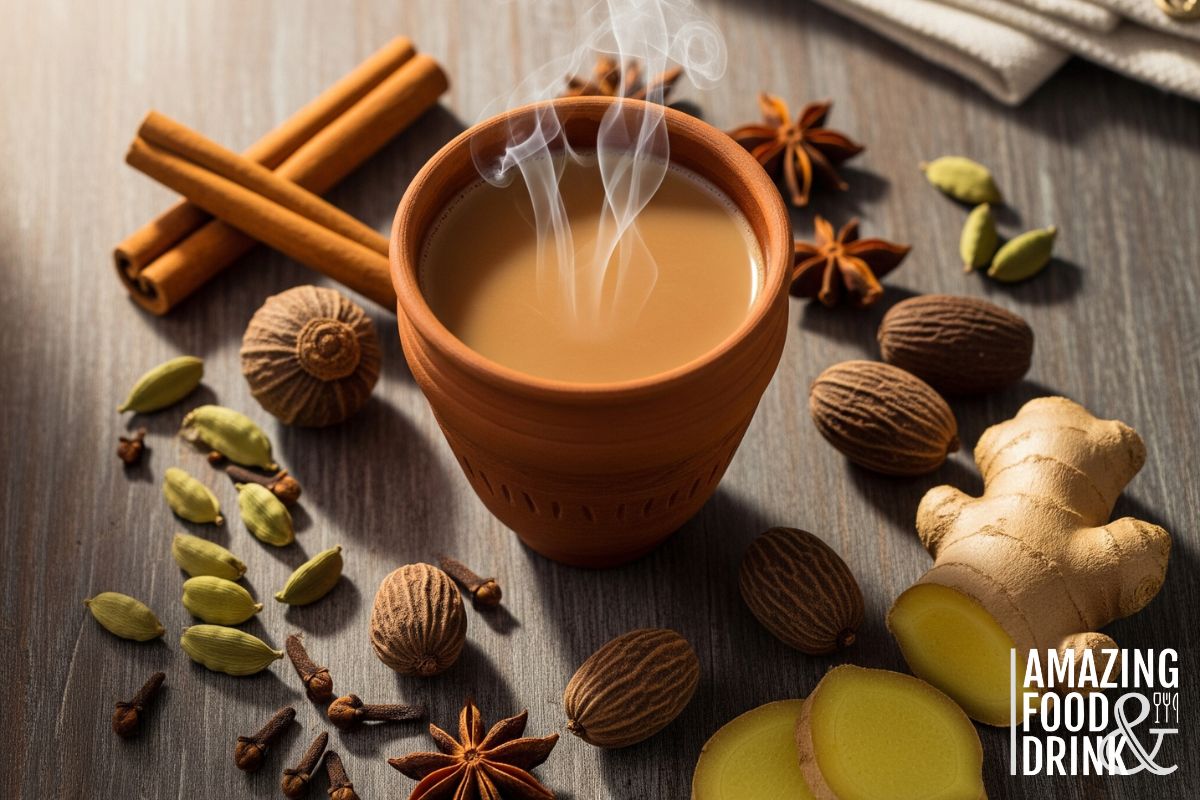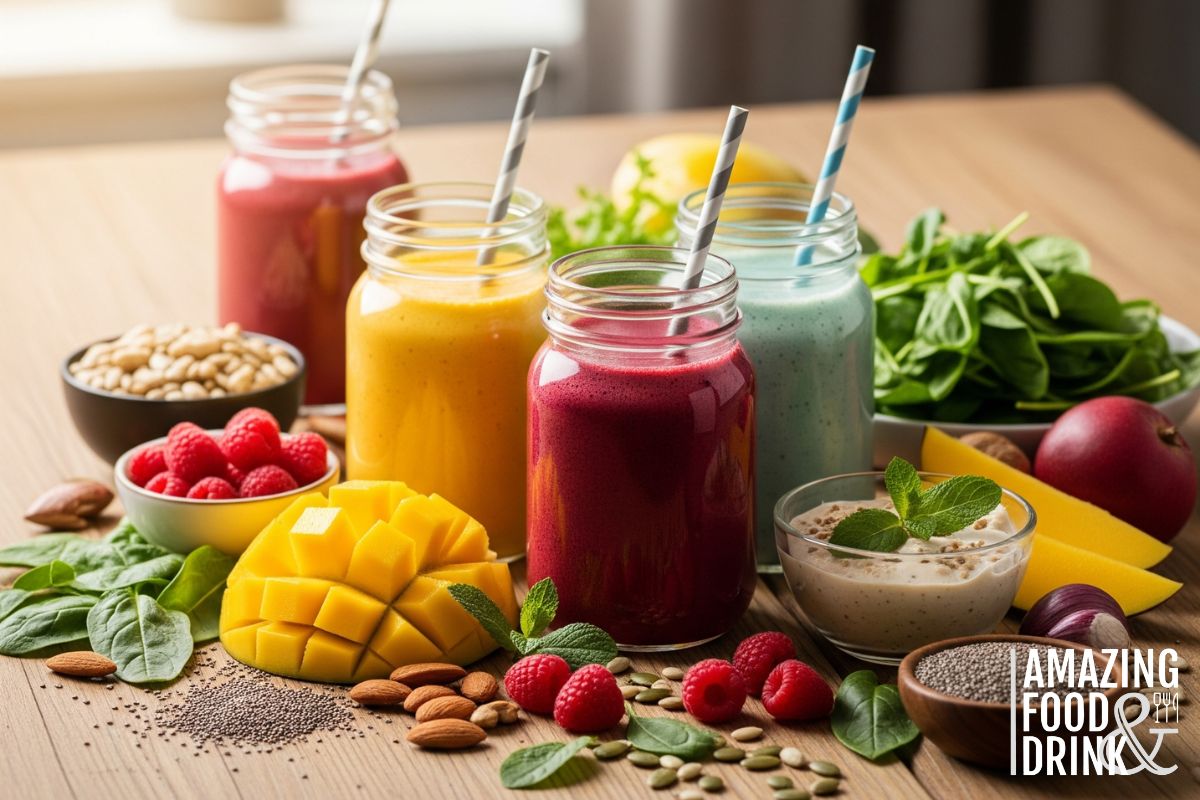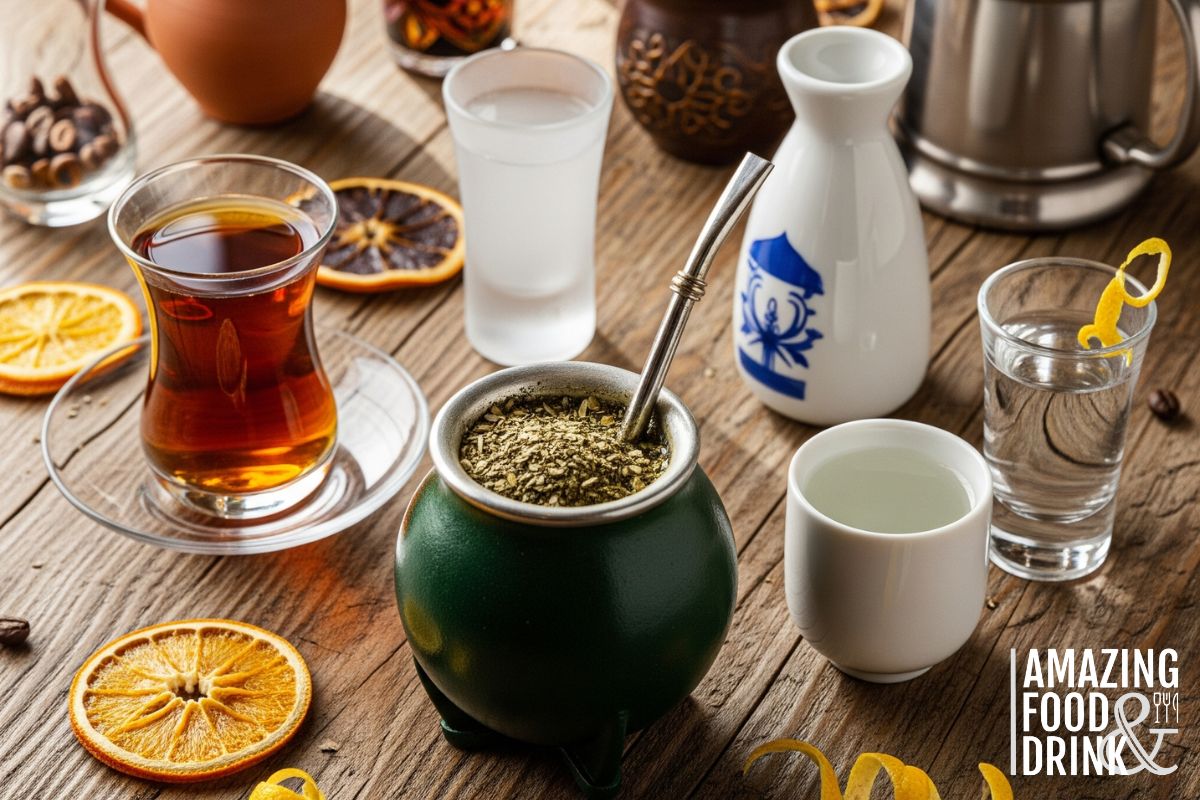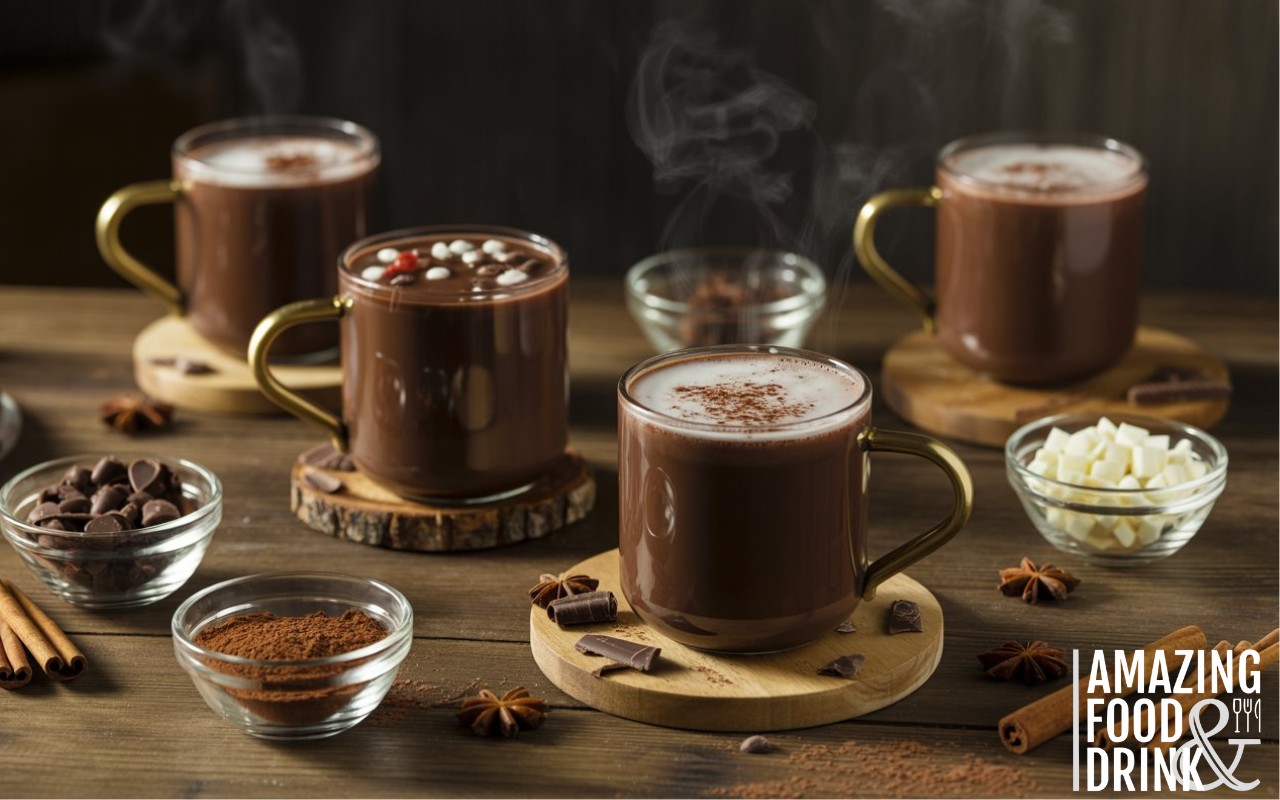Masala chai is India’s traditional spiced tea made by brewing black tea with aromatic spices (cardamom, Ginger, cinnamon), milk, and a sweetener. This beloved beverage combines the robust flavour of Assam tea with warming spices, creating a creamy, fragrant drink served throughout India.
This comprehensive guide will teach you everything about making perfect homemade masala chai, from understanding each ingredient’s role to mastering the traditional brewing technique.
Table of Contents
- What is Masala Chai?
- Masala Chai vs Regular Tea
- Health Benefits
- Masala Chai vs Chai Latte
- Jump to Recipe
What is Masala Chai? India’s Traditional Spiced Tea

Masala chai, literally meaning “spiced tea” in Hindi, is far more than a simple beverage. It’s the heart of Indian hospitality and daily life. Unlike regular tea, this traditional Indian spiced tea combines black tea with a balanced blend of aromatic spices, milk, and sweetener.
The word “chai” comes from the Chinese “cha,” which means tea. When Indians began importing tea from China centuries ago, they adapted both the name and preparation method, creating their unique version, which is now recognised as India’s national beverage.
Today, masala chai is served by chai wallahs (tea vendors) on every Indian street corner and in homes across the subcontinent, where recipes are passed down through generations.
Masala Chai vs Regular Tea: Key Differences

Understanding the distinction between masala chai and regular tea helps appreciate this beloved Indian drink:
Regular Tea:
- Simple infusion of tea leaves in hot water
- Available in five main varieties: black, green, white, oolong, and yellow
- Minimal processing and no additional ingredients
- Light, subtle flavours
Masala Chai:
- Black tea brewed with milk, spices, and a sweetener
- Always includes warming spices like cardamom and Ginger
- Requires longer brewing time for proper spice extraction
- Rich, complex, and creamy texture with warming properties
Health Benefits of Drinking Masala Chai Daily
For thousands of years, masala chai has been consumed for its delicious taste and remarkable health benefits. Combining black tea and traditional spices creates a powerhouse of wellness that modern science continues to validate.
Caffeine Content and Energy: Masala chai contains approximately 40-50mg of caffeine per cup, roughly half the amount in coffee. The milk and spices can slightly reduce caffeine absorption, providing a gentler energy boost without the jitters or crash associated with coffee.
Antioxidant Properties:
- Black tea contains polyphenols that fight free radicals and may reduce cellular damage
- Spices like cinnamon and cardamom significantly boost antioxidant levels
- Regular consumption may support overall cellular health and longevity
Cardiovascular Health:
- May help reduce cholesterol levels through tea polyphenols and cinnamon compounds
- Supports healthy blood pressure regulation
- Ginger aids circulation and heart health
- The combination may reduce the risk of heart disease when part of a healthy lifestyle
Digestive Benefits:
- Ginger contains gingerol compounds that soothe stomach discomfort and aid digestion
- Cardamom helps reduce bloating and supports healthy gut function
- The warming spices stimulate digestive enzymes
- It may help reduce nausea and motion sickness
Metabolic Support:
- Cinnamon may help regulate blood sugar levels and improve insulin sensitivity
- Ginger and other warming spices may boost metabolism slightly
- The ritual of drinking warm spiced tea can support mindful eating habits
Mental Wellbeing:
- Natural caffeine provides sustained energy without sharp spikes
- The warming spices have traditionally been used for stress reduction
- The ritual of making and drinking chai promotes mindfulness and relaxation
- Aromatic compounds may have mood-supporting properties
Bone and Immune Health:
- Milk provides essential calcium and protein for bone health.
- Spices contain various minerals that support bone density.
- Antimicrobial compounds in cloves and other spices may support immune function.
- Anti-inflammatory properties of Ginger and other spices support overall health.
How Each Masala Chai Ingredient Works

Understanding how each ingredient contributes to the final cup helps you create perfectly balanced masala chai every time. Each component is crucial in developing the complex flavour profile that makes this traditional Indian spiced tea so beloved worldwide.
The Foundation: Black Tea
Assam Tea forms the backbone of authentic masala chai, providing the essential tannins and caffeine that give the drink its characteristic strength. This robust, malty tea from Northeast India contains natural compounds that bind beautifully with milk proteins, creating the creamy texture that defines great chai. The high tannin content ensures the tea flavour doesn’t disappear when combined with milk and spices, whilst the caffeine provides sustained energy without the sharp spike of coffee.
Ceylon or English Breakfast teas work as alternatives, but avoid flavoured blends like Earl Grey, as the bergamot oil interferes with the traditional spice profile. The key is choosing a tea strong enough to hold its own against the assertive flavours of the masala blend.
The Heart: Essential Spices
Each Spice in the masala blend serves a specific purpose in creating the complex flavour profile that defines authentic masala chai.
Green Cardamom is the cornerstone spice, providing the distinctive floral and citrusy notes that define masala chai. Its essential oils release slowly during brewing, creating layers of flavour that develop throughout the cooking process. The pods should be lightly crushed before releasing maximum flavour compounds.
Fresh Ginger brings clean, bright warmth that energises without overwhelming other flavours. Unlike dried ginger powder, fresh Ginger provides complex flavour compounds that develop differently at various temperatures during brewing. It also acts as a natural flavour enhancer, helping other spices release their aromatic compounds more effectively.
Cinnamon contributes natural sweetness and warming properties, acting as a flavour bridge that harmonises diverse spice notes into a cohesive blend. The bark releases oils slowly during brewing, providing sustained flavour throughout the cooking process rather than a sharp initial impact that fades quickly.
Supporting Aromatics
Black Cardamom adds smoky depth and earthiness that grounds the lighter notes of green cardamom. Its larger size and different oil composition provide complexity without competing with the primary spices. Use sparingly, as its intense flavour can dominate the blend if overused.
Cloves contribute intense aromatic compounds that provide masala chai’s distinctive “warming” sensation. Their eugenol content creates the tingling sensation on the tongue that signals authentic spice balance and proper extraction.
Black Peppercorns add subtle heat and complexity. They contain compounds that enhance the flavour perception of other spices. They provide gentle warmth that builds gradually rather than sharp heat, creating depth without overwhelming delicate tea flavours.
Nutmeg rounds out the blend with sweet, warm notes that complement cinnamon, adding unique aromatic compounds. A small amount provides significant flavour impact, but too much can create overpowering or soapy notes that unbalance the blend.
The Creaminess: Milk Selection
Milk transforms masala chai from a simple spiced tea into a rich, comforting beverage beloved across India. The proteins in milk bind with the tea’s tannins, reducing bitterness while creating a smooth, velvety texture. Fat content affects flavour and mouthfeel. Higher-fat milks produce richer, more satisfying chai.
Traditional Dairy Options: Whole milk balances proteins and fats for classic texture and taste. The natural sugars in milk complement the spices without requiring additional sweetener.
Condensed milk creates an extra-rich, sweet version that is popular in some regions and uses less additional sweetener when choosing this option.
Plant-Based Alternatives: Different plant milks behave uniquely in chai brewing:
Coconut milk (full-fat) adds richness and subtle sweetness that beautifully complements the warm spices. Its higher fat content creates a luxurious texture similar to traditional whole milk.
Oat milk provides creaminess that is most similar to dairy, with natural sweetness and smooth texture that doesn’t compete with spice flavours.
Almond milk creates a lighter version that allows spice flavours to shine more prominently, though it may require slightly more sweetener to balance the tea’s tannins.
For those avoiding milk entirely, you can make spiced tea using only water, though this creates masala tea rather than traditional chai, it still benefits from warming spices.
The Balance: Sweeteners
Sweeteners don’t just add sweetness, they help extract flavour compounds from spices and balance the tannins in black tea. Different sweeteners contribute unique flavour notes: honey adds floral complexity, brown sugar provides molasses depth, whilst jaggery (traditional Indian palm sugar) contributes caramel-like richness with mineral undertones.
The sweetener also affects the brewing process; it should be added early enough to help extract spice flavours, but not so early that it caramelises and creates bitter notes.
Step-by-Step Masala Chai Recipe (Authentic Method)
Mastering the art of masala chai brewing requires understanding what to do and why each step matters. This detailed method guides you through the traditional process used in Indian households for generations.
Preparing Your Masala Spice Blend
The foundation of exceptional masala chai lies in properly prepared spices. This process awakens dormant flavour compounds and creates the aromatic intensity that defines authentic chai.
The Roasting Process: Preheat your oven to 180°C (160°C fan). Roasting spices transforms their flavour profile dramatically. Raw spices taste flat and one-dimensional, whilst properly roasted spices develop complex, layered flavours that bloom beautifully in hot liquid.
Spread all whole spices on a rimmed baking tray in a single layer, ensuring they don’t overlap. This allows even heat distribution and prevents some spices from burning whilst others remain under-roasted. The timing is crucial: 2-3 minutes creates the perfect balance between flavour development and preventing bitter, burnt notes.
Watch for visual and aromatic cues; the spices should become fragrant and slightly darker, but never black or smoking.
Watch out: Over-roasting creates bitter, acrid flavours that dominate the chai, whilst burning spices completely ruins the blend. Cinnamon bark will curl more tightly, cardamom pods may split slightly, and you’ll notice the distinctive warm aroma filling your kitchen.
The Cooling and Grinding Phase: Allow spices to cool completely before grinding. Hot spices release moisture that can create clumpy, uneven powder. This cooling period also allows the roasted flavours to stabilise.
For best results, use a dedicated spice grinder or clean coffee grinder. A mortar and pestle works but requires more effort and may not achieve the fine consistency needed for optimal flavour extraction. Grind in short bursts to prevent overheating, which can cook the spices further and create bitter notes.
The finished blend should be fine but not powdery, with a coarse flour texture. Store immediately in an airtight container to preserve the volatile oils that carry the flavours.
The Traditional Brewing Method
Authentic masala chai brewing follows a specific sequence that maximises flavour extraction, preventing common pitfalls like curdled milk or bitter tea.
Creating the Spice Base: Start with cold water in a heavy-bottomed saucepan; thin pans create hot spots that can burn spices or cause uneven heating. Bring one cup of water to a vigorous, rolling boil over medium-high heat. The active bubbling creates turbulence that helps extract spice compounds effectively.
Add your masala spice blend to the boiling water and immediately reduce heat to medium-low. This prevents the spices from burning whilst allowing proper extraction. The mixture should maintain a gentle simmer with small bubbles breaking the surface; vigorous boiling evaporates too much water and concentrates the mixture too quickly.
The Tea Addition: After 1-2 minutes of spice simmering, add the black tea. Whether using loose leaf tea or tea bags, this timing ensures the spices have begun releasing their flavours without becoming overpowering. The tea needs time to brew in the spiced water before milk is added. This creates a stronger tea base that won’t disappear when diluted with milk.
Watch the colour change as the tea steeps. It should deepen to a rich amber within 2-3 minutes. If using tea bags, gently press them against the pan sides to release more tannins, but don’t squeeze aggressively, as this can release bitter compounds.
The Critical Milk Stage: Pour the milk slowly while stirring gently. This prevents temperature shock that could cause curdling.
Watch out: Never boil milk vigorously as this leads to curdling and a bitter taste. The mixture will initially look separated and unappealing, but continued gentle heat will create the desired creamy consistency.
Add a sweetener at this stage; it helps extract the remaining spice flavours while the mixture heats. Different sweeteners behave differently: honey may foam slightly, brown sugar adds colour, and white sugar dissolves invisibly.
The Simmering Symphony: Bring the mixture to a gentle boil, then immediately reduce heat to low.
Watch out: Maintain a proper tea-to-milk ratio (1:1), as too much milk dilutes the tea, while too little makes it harsh. This is where patience rewards you. The slow simmer allows milk proteins to denature properly, creating a smooth texture while preventing scorching.
During the 8-10 minute simmer, you’ll notice several changes: the colour deepens to a rich caramel or tea-with-milk shade, the aroma intensifies and becomes more complex, and the volume reduces slightly as water evaporates and flavours concentrate.
Watch out: Under-extracting spices by insufficient simmering time results in weak, underwhelming flavour. Allow proper brewing time for full spice development.
Stir occasionally to prevent skin formation on the milk surface and ensure even heating. The mixture should bubble gently around the edges, but never boil vigorously. Aggressive boiling can cause the milk to curdle or develop an unpleasant cooked taste.
The Final Touches: Taste and adjust sweetening or spices as needed. This is your last chance to perfect the balance. The chai should taste rich and complex, with no single flavour dominating.
Strain through a fine mesh sieve to remove all spice particles and tea leaves.
Watch out: Use whole spices rather than pre-ground ones. Freshly ground spices provide superior flavour and aromatics, while pre-ground versions often taste flat and stale. Press the solids gently to extract the remaining liquid, but don’t force it. Over-pressing can release bitter compounds or allow fine particles through.
Serve immediately in prewarmed cups. Masala chai is best enjoyed hot, and the flavours are most balanced at serving temperature. The perfect cup should be aromatic, creamy, and warming, with a complex spice profile that lingers pleasantly.
Best Time to Drink Masala Chai

In India, masala chai isn’t just a beverage; it’s woven into the fabric of daily life:
Morning (7-9 AM): Perfect wake-up drink with biscuits or toast. The caffeine provides gentle energy without the jitters.
Afternoon (3-5 PM): Traditional tea time accompanies snacks and socialising. Ideal for a mid-afternoon energy boost.
Evening (6-8 PM): Relaxing end to the day, often shared with family. The warming spices aid digestion after meals.
Rainy Days: Nothing beats masala chai during monsoon season or cold British weather; the warming spices provide comfort and cosiness.
Storing Your Homemade Masala Spice Blend

Proper storage ensures your masala spice blend maintains its potency and flavour for months. The volatile oils that carry the distinctive chai flavours are delicate and require careful preservation.
Storage Requirements:
- Airtight container: Glass jars with tight-fitting lids or metal tins work best; avoid plastic containers, which can absorb and retain flavours
- Cool, dry location: Store away from direct sunlight, heat sources, and moisture
- Consistent temperature: Avoid areas with temperature fluctuations, like above the cooker or near windows
Maximising Freshness:
- Label everything: Date your blend and note the recipe for future reference.
- Small batch approach: Make smaller quantities (enough for 1-2 months) more frequently, rather than large batches that lose potency
- Whole vs ground: Store a small amount of ground for immediate use, keep the remaining whole spices to grind as needed
Shelf Life Guidelines:
- Freshly ground blend: 6-8 months for optimal flavour, up to 12 months usable
- Whole spices: 2-3 years when stored properly
- Quality indicators: Vibrant colour, strong aroma, and potent flavour signal fresh spices
Signs to Replace Your Blend:
- Faded colours, particularly in cinnamon and cardamom
- Weak or musty aroma when opening the container
- Lack of warming sensation when tasting
- Any signs of moisture or clumping
Masala Chai vs Chai Latte: What’s the Difference?
The global popularity of masala chai has led to Western adaptations, particularly the chai latte:
Traditional Masala Chai:
- Brewed by boiling tea, spices, milk, and a sweetener together
- Strong, robust flavour with pronounced spice notes
- Served hot in small portions
- Made with loose-leaf tea and whole spices
- An integral part of Indian culture and daily life
Chai Latte (Western Version):
- Made with concentrated chai syrup or powder
- Combined with steamed milk like a coffee latte
- Milder, sweeter flavour profile
- Often served hot or iced with whipped cream
- Created for coffee shop environments
- May contain artificial flavours and preservatives
While both are enjoyable, authentic masala chai offers a more complex, satisfying experience with genuine health benefits from fresh spices.
Winter Warming Masala Chai Variations

Adapt your masala chai recipe for British winters with these warming variations:
- Extra Ginger Chai: Double the fresh Ginger for warmth and digestive benefits.
- Cardamom-Heavy Blend: Increase green cardamom for a more floral, aromatic profile.
- Honey-Cinnamon Chai: Use honey as a sweetener and extra cinnamon for natural warmth.
Easy Masala Chai Recipe

Prep Time: 5 minutes
Cook Time: 15 minutes
Total Time: 20 minutes
Servings: 2 cups
Difficulty: Easy
Ingredients
For the Masala Spice Blend:
- 3 cinnamon sticks
- 1 whole nutmeg
- 50g fresh ginger, roughly chopped
- 5 black cardamom pods
- 15g green cardamom pods
- 10g black peppercorns
- 15g whole cloves
For the Chai:
- 1 cup water
- 1 cup whole milk
- 2 tablespoons loose black tea (or 2 strong tea bags)
- 1 tablespoon homemade masala spice blend
- 1-2 tablespoons sweetener of choice
Equipment Needed
- Heavy-bottomed saucepan
- Fine mesh strainer
- Spice grinder or mortar and pestle
- Rimmed baking tray
Quick Instructions
- To make a Spice Blend, Roast all spices at 180°C for 2-3 minutes. Cool completely, then grind fine. Store in an airtight container.
- Boil Water: Bring 1 cup of water to a rolling boil in a heavy-bottomed pan.
- Add Spices: Add 1 tablespoon spice blend, reduce heat to medium-low, and simmer 1-2 minutes.
- Add Tea: Add 2 tablespoons of black tea and simmer for 2-3 minutes until amber in colour.
- Add Milk: Pour in 1 cup of milk slowly whilst stirring, and add sweetener.
- Simmer: Bring to a gentle boil, reduce heat, and simmer 8-10 minutes until the mixture is a rich caramel colour.
- Strain & Serve: Strain through fine mesh, serve immediately in warmed cups.
Chef’s Tips
- Never boil milk vigorously, as it may curdle.
- Fresh Ginger makes all the difference.
- Adjust spice quantities to taste.
- The spice blend is kept for 6 months in an airtight container.
- Serve with biscuits or Indian snacks.
Nutrition (Per Cup)
- Calories: 120-150 (depending on milk and sweetener)
- Caffeine: 40-50mg
- Protein: 8g
- Calcium: 300mg
Storage
- Fresh chai: Best consumed immediately
- Leftover chai: Refrigerate up to 2 days, reheat gently
Making authentic masala chai at home connects you to centuries of Indian tradition whilst providing a delicious, healthy alternative to coffee. With practice, you’ll develop your perfect spice blend and brewing technique, creating a warming, aromatic beverage that brings comfort and joy to any day.
Whether you’re fighting off British winter chills or simply seeking a flavourful, caffeine-gentle energy boost, masala chai offers the perfect solution. Start with this traditional recipe, then experiment with spice quantities to create your signature blend.
FAQs
1. What’s the difference between chai and masala chai?
Chai means tea in Hindi, whilst masala chai refers to spiced tea with milk, sugar, and aromatic spices like cardamom and Ginger. All masala chai is chai, but not all chai is masala chai.
2. How much caffeine is in masala chai?
Masala chai contains approximately 40-50mg of caffeine per cup, roughly half the amount in coffee. The milk and spices can slightly reduce caffeine absorption, providing a gentler energy boost.
3. Can I make masala chai without milk?
Yes, you can substitute dairy milk with plant-based alternatives like almond, oat, or coconut milk for a vegan version. You can also make it with just water, which creates masala tea rather than traditional chai.
4. Why does my masala chai taste bitter?
Bitterness usually results from over-brewing the tea, using too high heat, or burning the spices during roasting. Keep the heat moderate and watch the timing carefully; never let the milk boil vigorously.
5. What’s the best ratio of tea to spices?
For 2 cups of masala chai, use 2 tablespoons of black tea and 1 tablespoon of spice blend. Adjust according to your taste preferences; some prefer stronger tea, others more pronounced spice flavours.
6. Can I use tea bags instead of loose-leaf tea?
Yes, strong black tea bags work well as a substitute for loose-leaf tea. Use two tea bags for two cups of chai and remove them after the initial brewing phase before adding milk.



